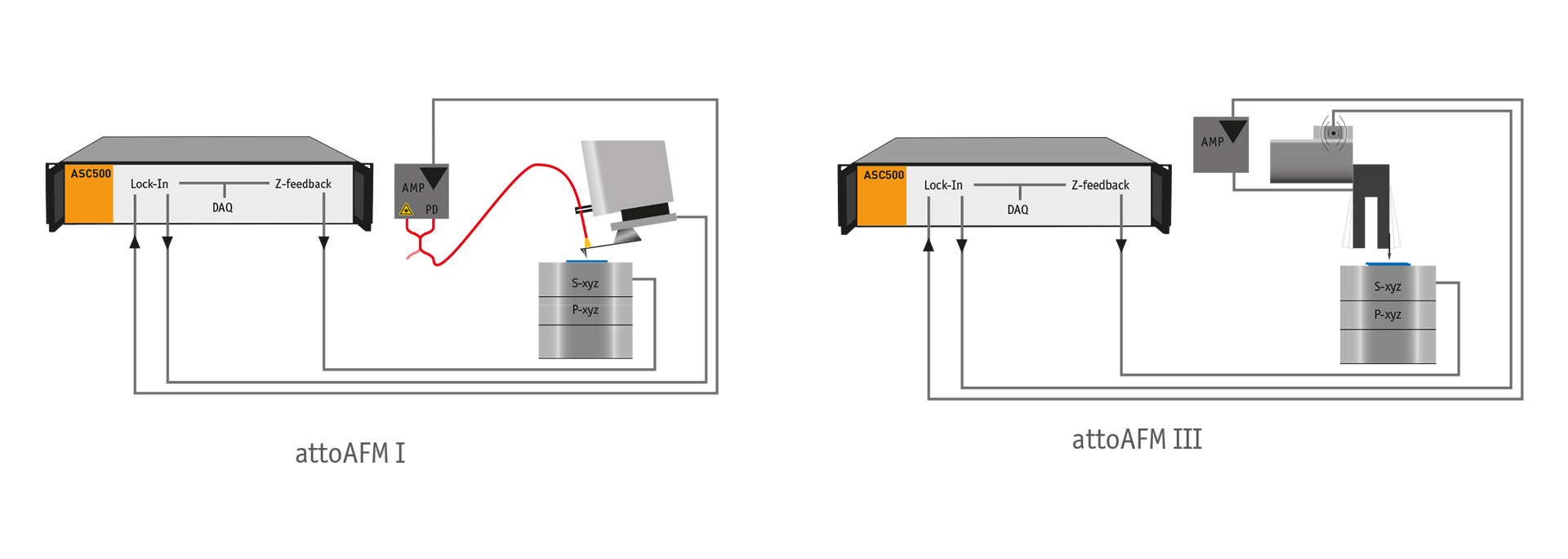Atomic Force Microscopy (AFM)
The atomic force microscope (AFM) is a spin-off from the scanning tunneling microscope (STM), designed with the intention to measure the topography of nonconductive samples. It surpasses the limitations of conventional optics and is an extremely accurate and versatile instrument enabling investigations of surface topography, tip-sample interaction forces, and magnetic surface phenomena (-> MFM).
The simplest operational mode of every AFM is referred to as ‚contact mode‘. A very fine tip mounted to the end of a small deflecting spring – known as cantilever – is brought into contact with the sample surface. The tip is then moved across the surface in consecutive line scans to form an image. Any vertical deflection of the tip due to short-range repulsive interaction forces with the sample can be measured and recorded with very high accuracy. Over the years, more sophisticated AFM modes have evolved such as non-contact mode (nc-AFM) and frequency modulated non-contact mode (FM-AFM). In contrast to contact mode, the nc-AFM mode is sensitive to large range attractive forces such as those caused by van-der-Waals, electrostatic, and magnetic interactions. The latter resulted in the development of the magnetic force microscope (MFM), an instrument which is nowadays widely used in applications such as vortex imaging and magnetic thin film analysis.
Interferometric Sensor
In order to detect tip deflections, the attoAFM I uses an all-fiber low- coherence interferometer. The schematic drawing below on the left shows the setup: a laser beam is coupled into a single mode fiber to illuminate an interferometer: some light is reflected at the fiber end face, while light exiting the fiber is partially reflected by the AFM cantilever. Therefore, the tip and the fiber end form a Fabry-Pérot cavity. The light reflected from this structure is then routed to a photo detector that monitors the intensity variations and thus traces back the tip displacement.
This detection mode is compatible with commercial cantilevers, and enables standard imaging modes such as MFM, electric force microscopy (EFM), Kelvin Probe Force Microscopy (KPFM), Piezoresponse Force Microscopy (PFM) etc.
Tuning Fork Sensor
The attoAFM III uses a tuning fork sensor to detect tip-to-sample distance variations, allowing high resolution non-contact mode imaging without an optical detection system (see schematics below on the right side). An AFM tip is glued onto one leg of a small quartz tuning fork, and forced to oscillate in the horizontal direction with typical amplitudes of about 50 pm. Damping of this amplitude by tip-sample interaction forces is monitored and used as feedback signal. The force resolution of this technique is typically 0.1 pN. AFM tips can simply be home-made, but are also commercially available. Being non-optical, this deflection detection mechanism is perfectly suited also for light sensitive specimens, such as for scanning gate microscopy (SGM) on a 2-dimensional electron gas (2DEG).


